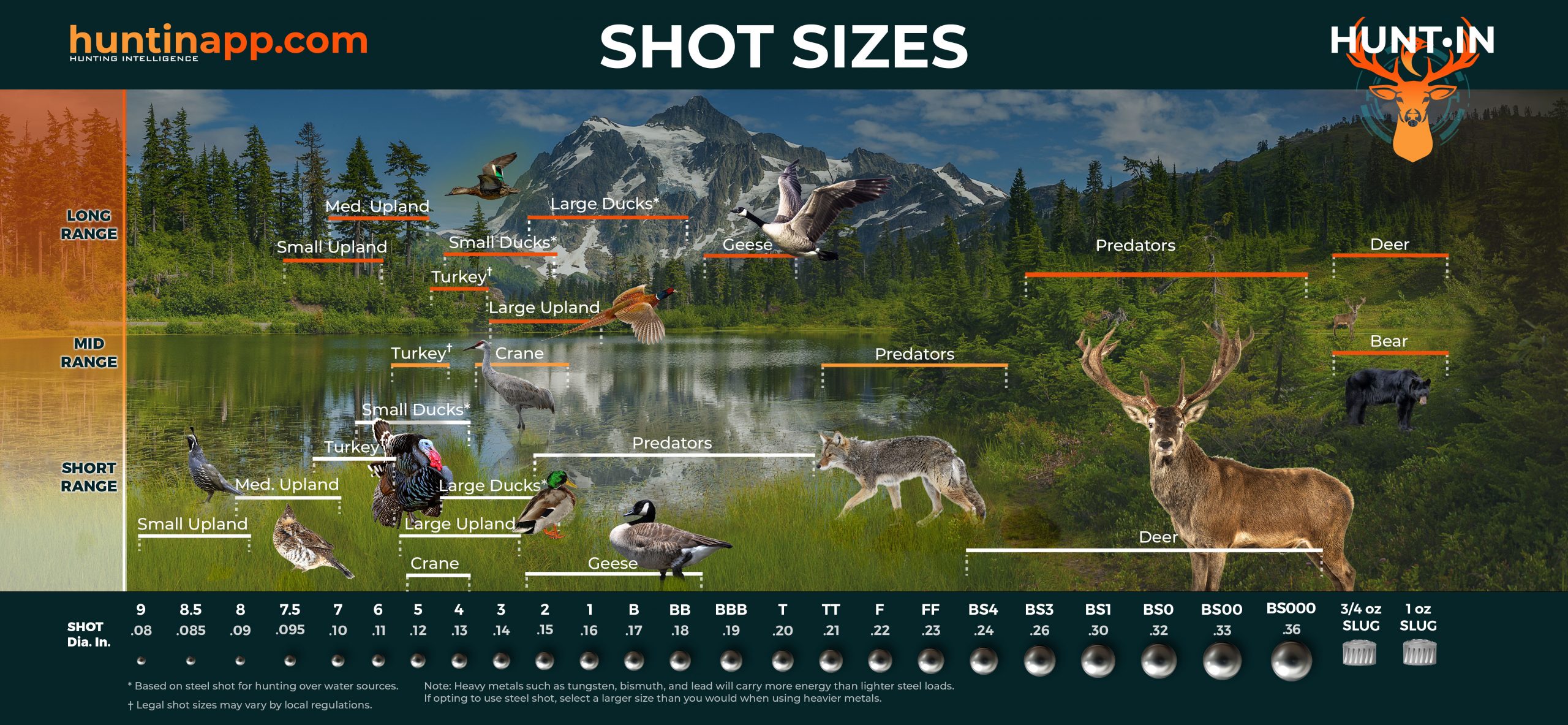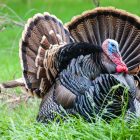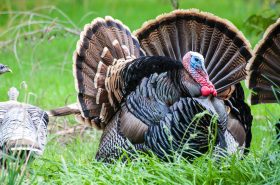When it comes to shotgun ammunition, there is certainly no shortage of options available. Different shot sizes, shot materials, and shell sizes are the main considerations hunters take when picking a box of shells, and these options can be both a good and a bad thing. For experienced hunters, this can mean a range of great options to tailor your shotgun load perfectly for the game and conditions you are hunting. For new or novice hunters, however, this mountain of options can seem overwhelming and make it difficult to hone in on an appropriate selection of what you are hunting. In this article, we will break down some of the various aspects that you should consider when selecting a shotgun load: including shot size, pellet distribution, impact force, and shot material. When you’re through this article, you should feel confident when grabbing your next box of shells.
OVERVIEW OF SHOT SIZES
Shot size refers to the physical size of the pellets that are loaded into the shell. For most conventional hunting purposes this ranges from 9 shot, being the smallest, up to Buckshot 000 (or BS000), being the largest. To give you a better understanding of their sizes, a 9 shot pellet has an average diameter of 0.08 inches whereas a BS000 pellet has an average diameter of 0.36 inches. With pellets generally varying in increments of 0.01 inches between shot sizes, you can see this leads to quite a range to choose from. For a full display of typical hunting loads, check out this Hunt-In diagram. In the most basic sense of it, the larger the game the larger the pellet. As we all know, however, it’s not exactly that simple.
DIFFERENT SHELL SIZES AND GENERAL IMPACT ON SHOTS
I’ll quickly divert here from shot sizes to shell sizes to give a brief understanding of these before progressing. Shotgun shells common to hunting are 2 3/4 inches, 3 inches, and 3 1/2 inches. Shell length is independent of shots size and you can find most shot sizes are available in these shell lengths. So, what do shotgun shell sizes equate to in shooting and hunting terms? In General, the longer the shell, the more pellets and powder that are loaded into it. This can mean a combination of more pellets in your spread (and more chance of hitting your target) and faster pellet speeds. While you may be thinking, these both seem like great advantages, why not just shoot 3 1/2 inch shells all the time… that would be because these large shells come with a price, and that is recoil. For those of you that have fired 3 1/2 in shells, you’ll know your shoulder isn’t thanking you after pumping a few rounds out. This greater recoil can also make quick follow up shots more difficult. Further, in many cases, 3 1/2 inch shells are overkill where a 3 or even 2 3/4 inch shell will get the job done. Increasing your shell length can be beneficial in a few key scenarios. I) If you are shooting long distances and need your pellets to travel further to hit your target. II) If you are shooting at fast-moving targets the faster pellet speeds can be beneficial. III) For larger targets where you want your pellets to carry more energy into impact to help ensure a clean kill.
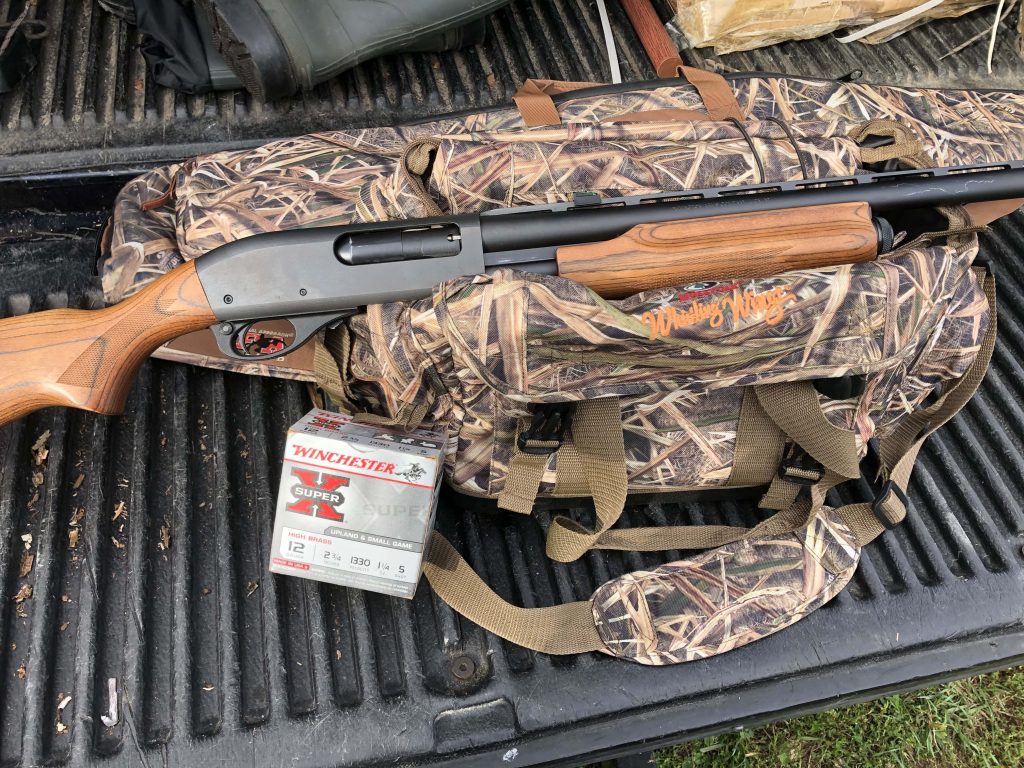
SHOT DISTRIBUTION ACROSS SIZES
One of the most important things you need to do in order to hunt effectively is to know your gun. In this instance, knowing how your shotgun patterns certain loads can greatly improve your success in the field. A pattern refers to the spread of the pellets on impact at various yardages. There are a number of factors that contribute to how your pellets will pattern, pellet material, load size, even different brands of ammunitions will pattern differently from gun to gun. Trying different ammo is a great way to figure out what selection will give you the best patterns. Obviously adjusting your choke tube will also affect your pattern, but for the purposes of this discussion, we’re going to assume you have your desired choke in and shot material selected. Now it comes down to shot size and which shot size to pick. As mentioned above, generally the smaller shot sizes are best for smaller game and larger shot for larger game. As a few quick examples, for upland birds, shot sizes from 9-1 can all be good, for ducks, shots from 6-B can be good, and for geese, 2-T. While these are still fairly large ranges at first glance, you’ll further detail your selection here based on the size of the game in these categories, and the distances you are shooting, which is further detailed below.
When the same shell size is considered, using a smaller shot size will mean more pellets are loaded into your shell compared to larger shot sizes. Theoretically, this should mean that your pattern density with a smaller shot size should be greater at a given distance as there are more pellets in the spread. As you increase the size of your pellets and reduce the number, your spread becomes less dense with larger gaps between your pellets. You want to balance this ratio by selecting a shot that will be large enough and pack enough energy to adequately penetrate your target allowing for an effective kill, while also ensuring the spread is tight enough that enough pellets will hit your target. To put this into a scenario for you, while #1 shot may be good for large pheasants and obviously pack enough punch for smaller Bobwhites. Because there are fewer pellets in the load, when shooting at a smaller target such as the Bobwhites, fewer (or no) pellets may make contact with the target’s vital areas, rendering them less effective. Whereas smaller shot sizes such as 8 shot will still pack enough energy to take down your Quail and ensure enough pellets hit home to get the job done.
ADVANTAGES AND DISADVANTAGES OF TIGHT GROUPINGS
While pattern density is important to consider, so is the overall size, or spread, of your pattern. While this is mostly a function of other factors such as your choke tube selection, pellet material, and shot speed, there is some suggestion that pellet size plays a role in this as well. In short, the smaller and lighter the pellet is, the faster it can disperse meaning smaller loads will have a slightly wider spread than a larger heavier laid. In hunting, both wider and tighter spreads have their advantages. For example, when wing shooting, especially at fast-moving targets, having a wider spread (that still has a good pattern density) will give you better coverage and a chance at hitting your moving target. On the other hand, if you are often shooting still targets, say a turkey, keeping a tighter pattern can be beneficial as it will keep more pellets in the target ranging, both increasing the impact in the vital areas as well as reducing the potential of hitting the desired meat on your target.
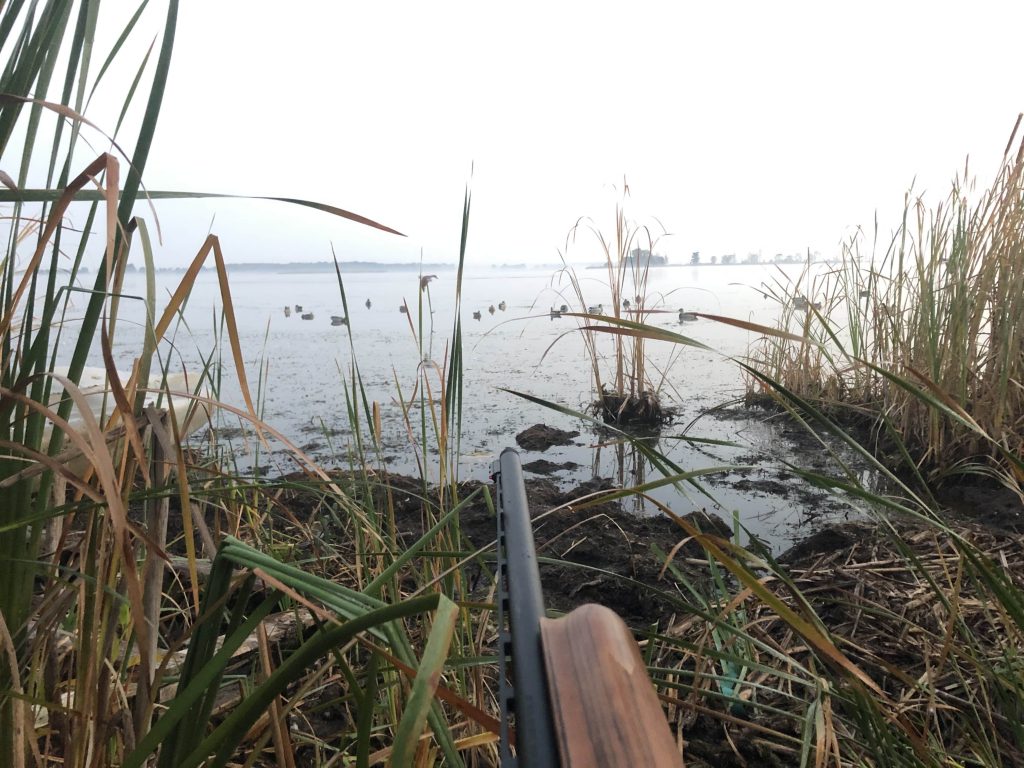
IMPACT FORCE: SHOT SIZE VS DISTANCE
One of the final things to consider when selecting a shot size is the distance you are shooting. Smaller loads are lighter and they lose their energy faster when leaving the barrel. Larger, heavier loads will hold their momentum longer and keep more energy at further distances. So, when shooting short distances, lighter loads can give you a better spread and be effective for taking down your target, However, when shooting longer distances, increasing the size of your load will help make sure your pellets still have enough energy to penetrate your target and hit the vitals. Let’s talk about this in terms of waterfowling. When hunting in small ponds and marshes, you will often be shooting in close quarters, maybe 15-20 yards, and using #4 can often be ideal. However, if you move out to more open waters, shots out to 35-40 yards may be more standard and those #4s may not carry enough energy here. Moving up to #3s or #2s can be ideal in these scenarios when shooting at the same ducks you would be using your #4s for in the pond.
If you really don’t want to up the size of your shot, you can also increase the energy of your shot at a greater distance by increasing the speed. As mentioned above increasing your shell size, from 2 3/4 to 3, or from 3 to 3 1/2 will generally lead to increased pellet velocity out of your muzzle. While this can also be an effective option, there really isn’t much reason to shy away from going up a couple of sizes to get a more effective shot and keeping a shell length you are comfortable with.
SHOT MATERIAL, LEADS, STEALS, TUNGSTEN/BISMUTH, BLENDS
Different shot materials are another, and increasingly common, factor to consider when selecting your shotgun loads. While lead and steel used to dominate the industry, various other options such as tungsten, bismuth, or even blended options like copper-plated lead shots are available. These “heavy” shot options are becoming increasingly popular, especially for larger game such as turkey. This is because these denser metals carry more weight and energy, hitting their target with a real punch. When it comes to shot sizes, this often means you can decrease the size of your pellets, offering more pellets in your spread, while maintaining the impact energy of larger shot sizes. So if you often use #5 lead shot for turkey, going down to a 6 or 7 tungsten shot will still provide all the power you’re used to out of your 5 shot lead, but increase your pellet count at the point of impact. Or you can stick with #5 tungsten and rest assured you’re pellets are going to wallop that gobbler.
Steel on the other hand requires a move in the opposite direction. Steel is much less dense than lead, so pellets of the same diameter will carry less energy towards to point of impact. If you are thinking you normally use 5 lead shot, going to 4 or 3 shot with steel will be a necessary adjustment.
It is also important to know how your gun patterns these different materials. Metals such as steel are much harder than lead, meaning they don’t deform as much and hold a tighter pattern than lead. This will again be key to identifying the right pattern density for your conditions and the shot size in accordance with this.
TO SUMMARIZE all this in a few quick thoughts. The key attributes to consider when selecting the appropriate shot size are 1) What is the size of game you are hunting, 2) What are the distances you will be shooting, 3) What will be your shooting conditions and 4) What materials you are shooting.
Remember to adjust the shot sizes in accordance with the size of game you are hunting. If you are shooting short distances, smaller shot sizes in the appropriate range will be best, whereas longer shots may require larger shot sizes. If you are shooting at fast-moving targets, having a wider spread will help increase your odds at hitting your target. Whereas if you are shooting at still or slow moving targets, a denser pattern will increase your pellet count in the vital areas. And lastly, heavier shots can allow you to decrease your shot size while maintaining the effective energy or a lighter load in a larger shot size.



